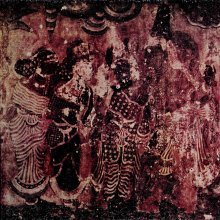Shilparatna, Śilparatna, Shilpa-ratna: 2 definitions
Introduction:
Shilparatna means something in Hinduism, Sanskrit, the history of ancient India. If you want to know the exact meaning, history, etymology or English translation of this term then check out the descriptions on this page. Add your comment or reference to a book if you want to contribute to this summary article.
The Sanskrit term Śilparatna can be transliterated into English as Silparatna or Shilparatna, using the IAST transliteration scheme (?).
Images (photo gallery)
In Hinduism
Vastushastra (architecture)
Source: archive.org: Bharatiya vastu-sastraŚilparatna (शिल्परत्न) (together with Mānasāra and Mayamata) represents standard works on Hindu architecture belonging to the most flourishing school of South India, what is called Drāviḍa-Vāstuvidyā or Maya school of Architecture representing three stages of development, the early, the early medieval, and medieval-cum-modern periods of architectural history.—The Śilparatna, as already remarked is comparatively a modern manual, hence by its time both the styles of temple-architecture were fully developed. Naturally this subject is not very haphazardly treated.

Vastushastra (वास्तुशास्त्र, vāstuśāstra) refers to the ancient Indian science (shastra) of architecture (vastu), dealing with topics such architecture, sculpture, town-building, fort building and various other constructions. Vastu also deals with the philosophy of the architectural relation with the cosmic universe.
India history and geography
Source: Triveni: Journal (history)Silpa-Ratna of Sri Kumara is the name of a Sanskrit work dealing with Iconography.—Sri Kumara, author of Silpa-Ratna, lived at the close of the 16th century A. D. He was a Kerala Brahmin belonging to Bhargava Gotra, and, as found in the closing colophon, was the son of Sri Rama. Reference is given to the place where he lived which is Chiramelkadu sanskritised by himself as “sethurdwakanana-nivasakritadhivasam” a deja now found in the Talapalli Taluk in Cochin State. The second part of the Silpa-Ratna consists of 35 Chapters dealing with iconography and other allied matters.

The history of India traces the identification of countries, villages, towns and other regions of India, as well as mythology, zoology, royal dynasties, rulers, tribes, local festivities and traditions and regional languages. Ancient India enjoyed religious freedom and encourages the path of Dharma, a concept common to Buddhism, Hinduism, and Jainism.
See also (Relevant definitions)
Partial matches: Shilpa, Ratna.
Full-text (+131): Shribandha, Shadadhara, Kashmira, Vardhaki, Gangeya, Sutragrahin, Takshaka, Lepa, Sthapati, Mrinmayakudya, Kaurava, Vaideha, Lupa, Kaushala, Shaurasena, Magadha, Avantika, Shaundika, Simhakanta, Kalinga.
Relevant text
Search found 13 books and stories containing Shilparatna, Śilparatna, Śilpa-ratna, Shilpa-ratna, Silparatna, Silpa-ratna; (plurals include: Shilparatnas, Śilparatnas, ratnas, Silparatnas). You can also click to the full overview containing English textual excerpts. Below are direct links for the most relevant articles:
Vastu-shastra (1): Canons of Architecture (by D. N. Shukla)
(vi) Mayamata [Mayamatam] (Summary) < [Chapter 5 - Study of Hindu Science of Architecture]
(vii.a) Śilparatna (Introduction) < [Chapter 5 - Study of Hindu Science of Architecture]
(iv) Other Ācāryas (chief preceptors) of Vastuśāstra < [Chapter 4 - An outline History of Hindu Architecture]
Manasara (English translation) (by Prasanna Kumar Acharya)
The thirty-two plans of the Mānasāra < [Notes]
Chapter 7 - The Ground Plans (padavinyāsa-lakṣaṇa)
Head-Gears in Hindu Art < [March 1937]
Theatre-Architecture in Ancient India < [January-February 1933]
Semantic Attitudinisation < [July – September, 1985]
Vastu-shastra (5): Temple Architecture (by D. N. Shukla)
Chapter 6 - General remarks (on temple-classification)
Chapter 7 - Planning of Prāsāda—The Hindu Temple
Vishnudharmottara Purana (Art and Architecture) (by Bhagyashree Sarma)
8(b): The Image of Various Gods < [Chapter 5 - Painting and Image Making]
8(a): Image Making: The Concept < [Chapter 5 - Painting and Image Making]
7(b): Portrait of Different Classes Projected in Painting < [Chapter 5 - Painting and Image Making]
Kashyapa Shilpa-shastra (study) (by K. Vidyuta)
3. Date of the Kāśyapa Śilpaśāstra < [Chapter 2 - Author and his Works]
6. Scope and Focus (of the Present Study) and Conclusion < [Chapter 1 - Introduction]
2 (b). Vāstuśāstra texts < [Chapter 1 - Introduction]
